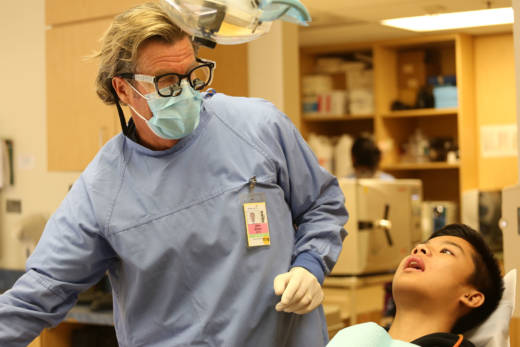The moves fit into a larger state focus on prevention as a way to reduce chronic conditions, emergency care, surgeries and the high related treatment costs. Medi-Cal covers about a third of Californians and consumes more than $100 billion annually in state and federal money. Denti-Cal accounts for about 2 percent of that, or just under $2 billion.
Not long ago, Blake said, he was exasperated by the state program; some of its payment rates were “almost comically low.” His nonprofit clinic had mostly Denti-Cal patients, and he needed private donations to fund about half of his operating expenses. The system was a constant hassle, with unnecessary paperwork and delayed payments.
“I was one of the fiercest critics of Denti-Cal,” Blake said. “I can remember sitting before the Legislature and telling them, ‘This is not a functional program.'”
But in the past few years, the state has aside money for rate increases — $210 million in the current budget. It has also signed up hundreds more dentists, expanded the number of patients seen by individual providers and placed new emphasis on prevention, according to the California Department of Health Care Services, which oversees Medi-Cal.
“Now I have to give them some praise,” Blake said. Almost all of the problems and possible solutions he testified about years ago have been addressed or implemented, he said — although he’ll continue fundraising because the increases still don’t meet his costs.
“These changes at Denti-Cal are great … And I can tell you,” he said with a little chuckle, “I don’t think I’ve ever used ‘great’ and ‘Denti-Cal’ in the same sentence before.”
The Little Hoover Commission, a state oversight panel, has also pushed for change.
It initiated public hearings in 2015 to examine Denti-Cal’s rock-bottom utilization rates — at the time, only a third of enrolled children ages 3 and younger had seen a dentist in the previous year. The commission issued a damning report in 2016 that called the system “broken” and one of the state’s “greatest deficiencies.”
“It’s not there still,” Blake said, adding that payments now are about 30 percent of what he’d get from private insurance — better than the 25 percent or so he used to get, but not enough. And “paperwork is still a factor,” he said.
Signing up dentists with a negative view of Denti-Cal has been a big challenge for the department. But the latest data shows a turn. A recent report from the Department of Health Care Services says that, from July 2017 to March 2018, 360 new providers joined Denti-Cal, bringing the participant total to nearly 10,000.
And from 2014 to 2016, the department reported, the number of dentists seeing 10 or more Denti-Cal children rose by more than 6 percent, which means roughly 400 more dentists across the state have expanded their practices to include more low-income kids. Cash bonuses go to those who expand their Denti-Cal load by 2 percent, a target that will grow to 10 percent over five years.
In addition, the state has:
- Expanded teledentistry efforts, allowing providers to supervise some care remotely, increasing their availability to underserved areas.
- Switched to electronic billing and trimmed paperwork requirements.
- Begun testing ways to reach more patients and offer better preventive services, through the pilot programs across California. In Sonoma County, for instance, the goal is to eliminate new cavities in 75 percent of children within five years.
- Appointed a state dental director, Jayanth Kumar, charged with reducing oral-health disparities in California and developing a statewide oral-health plan in coordination with multiple government agencies.
Harvey Lee is chief dental officer for the nonprofit Healthy Smiles for Kids, which provides care to low-income children in Orange County. He said the Denti-Cal changes helped convince him to treat low-income youngsters, outside of his fee-for-service practice in Irvine.
He had heard “the nightmare stories of waiting for six months to get approval” as a provider, … and the red tape, … submission of X-rays and so forth just to get pennies on the dollar.”
But he was approved in a week. A Denti-Cal representative even came to his office to help with his application. Lee said the payments aren’t as high as what he gets in private practice, but “the increase helps.”
“Most dentists just know the old Denti-Cal, but they don’t know the little nuances in how it was improved,” Lee said. He’s treating a high volume of Denti-Cal patients through teledentistry.
With that kind of innovation, said Alani Jackson, chief of dental services at the Department of Health Care Services, “it’s like we’re riding the right wave of change.”
The main goal of the system overhaul is to establish a dental “home” for patients, where one dentist coordinates care for an individual or family. That can help lead to a lifetime of better oral health, Jackson said. And lower costs for the state.
In particular, the department is focusing on children 6 and younger. Jackson said the pilot program in Orange County includes presentations at schools. “We’re going to where the kids are,” she said.
There’s still work to do, Jackson and her staff acknowledge. And their successes must be maintained for the long term. Katie Andrew, oral health senior associate at Children Now, a nonprofit health advocacy group in Sacramento, agreed.
“For patients,” Andrew said, “this hasn’t been a dramatic change. Many still don’t know about Denti-Cal benefits, and in the rural counties especially, there just aren’t enough providers.”
Blake said it will take “many years to rebuild that system of care and earn back the trust of California’s dentists … Many dentists are waiting in the wings to see if this can be sustained.”
Meanwhile, Lee expressed surprise at how much it means to him to care for low-income, high-need patients.
“I never really thought I’d enjoy this part of being a dentist,” Lee said. “But it’s wonderful. I mean, you’re not doing it to make money, you do it because there’s a need.”

